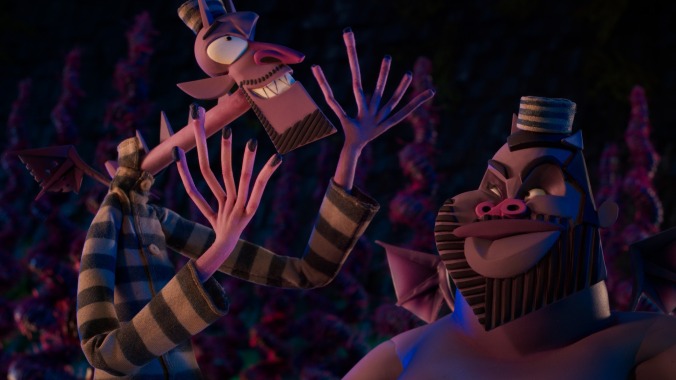Henry Selick and Jordan Peele dream big—maybe too big—in the animated frightmare Wendell & Wild
A troubled teen struggles with demons both serious and comedic in this stop-motion film that also marks a reunion of sorts for Keegan and Peele

Wendell & Wild, the promising-on-paper collaboration between stop-motion legend Henry Selick and nouveau-horror maestro Jordan Peele, is about two demons who hatch a plan to open a theme park. It’s also about an orphaned teenage girl with survivor’s guilt. It’s also about an evil corporation scheming to build a for-profit prison. Wendell & Wild is about a lot of things. Too many things, actually. But it’s so packed with gloriously demented visuals and bold thematic swings that try, with varying degrees of success, to lift the film out of the realm of pure fantasy, that we’re not entirely bothered by the convoluted story. It’s a bit disappointing that these two visionary filmmakers couldn’t combine their formidable talents to create a more smoothly cohesive work. Nonetheless, it’s just too damn gorgeous to dismiss and the inclusionary characters modernize the animated antics in ways that will resonate with young adult audiences.
It’s a tip off to the film’s unruly nature that its title is Wendell & Wild yet neither of them is our hero. That would be 13-year-old Kat (voiced by Lyric Ross), a sullen and angry girl who blames herself for the death of her parents in a car accident five years earlier. She’s since become a behavioral challenge, which necessitates a return to her once thriving, now crumbling hometown of Rust Bank to enter a program for at-risk teens at the Rust Bank Catholic School for Girls. Kat is an outcast for reasons that go far beyond what most young leads experience in mainstream, youth-targeted animated fare. It allows Peele, who co-wrote the film with Selick, to put his sociopolitical stamp on another director’s material, and Selick to add representation to his traditional portrait of the plucky, troubled kid.
While Kat raises hell at Catholic school, down in the underworld Wendell (Keegan-Michael Key) and Wild (Peele) perform prison labor on a hair farm, riding a tardigrade that drills holes and squirts hair gel into the enormous head of Buffalo Belzer (Ving Rhames), their demon father who runs an amusement park of the damned on his fat stomach. If that sounds like a mouthful, get ready, because Wendell & Wild spirals and curlicues more than Belzer’s ghost-filled rollercoaster. Hell Maidens, Bearz-a-bubs, shapeshifting octopuses and the rules that dictate the interaction between the underworld and the Land of the Living make for some fuzzy world-building. Selick clearly wants us to just go with it since he’s creating as many opportunities to dazzle us as possible. And maybe we should, but it bogs down large chunks of the film, as do the often sluggish line readings that affect Peele, Key and the rest of a terrific voice cast that includes James Hong as the school headmaster, and Angela Bassett as a nun with a secret.
The enervated pacing is easier to endure when every visual element is a dark and disturbing delight, starting with the character designs credited to Argentinian designer Pablo Lobato. With her green hair, eyebrow piercings and “don’t mess with me” combat boots, Kat is a punk rock disruptor, the better to hide her anger and insecurity. Wendell and Wild’s designs are sights to behold. They look like Key and Peele as designed by Picasso during his Cubism period and then handed off to Rankin and Bass. Demons, corpses, skeletons and ghosts are placed within frames that explode with color and movement and barely seem wide enough to contain all the action. The stunning stop motion work is CGI-enhanced, which puts a dent in its purity, but objects are so mesmerizingly tactile. You can see every thread in Kat’s clothing, and every marvelous imperfection in props like Cyclops, the boombox owned by Kat’s late father that is now her treasured possession.
While Selick appears determined to animate every phantasmagorical idea he’s dreamt up since his last feature, 2009’s Coraline, Peele drags the film into the real world. When Kat agrees to bring Wendell and Wild into the Land of the Living in exchange for reanimating her parents, it leads to some anti-corporate messaging and criticism of our revolving door prison system that ensnares young adults like Kat for life. It’s a brave stand for an animated film to take and it might have hit harder if it wasn’t swathed in layers of story complications that make these valid points feel imposed upon Selick’s style rather than natural extensions of it.
What resonates in a quietly powerful way is the film’s progressive cast that includes Kat’s trans schoolmate Raul (Sam Zelaya) and Kat’s Indigenous case worker Ms. Hunter (Tantoo Cardinal). And then there’s Kat herself, the inclusive-minded evolution of the Selick heroine, one who’s dealing with, or coming to terms with, absent, neglectful or misunderstood parents. Here, the parenting issues extend to Catholic student Siobhan (Tamara Smart), whose mom and dad see dollar signs in America’s prison industrial complex, and Wendell and Wild themselves, whose father is not just cruel, he’s the actual Lord of the Underworld.
Selick and Peele operate a bit at cross purposes in Wendell & Wild. The genius visualist wants to haunt our dreams. The socially engaged provocateur wants to haunt our troubled collective realities. Whatever doesn’t quite mesh in their collaboration is easier to forgive when feasting upon such extraordinary sights. This long overdue return of the rightly hailed Selick combines the hellzapoppin, holiday frightmare energy of The Nightmare Before Christmas with the girl-power heroics of the exquisitely creepy Coraline. Even with its refreshingly modern messaging, it’s Selick’s old-fashioned, lovingly crafted style, where each blemish only adds to its charm and you can feel the hand of its creator in every shot, that feels more inspiring and needed than ever.